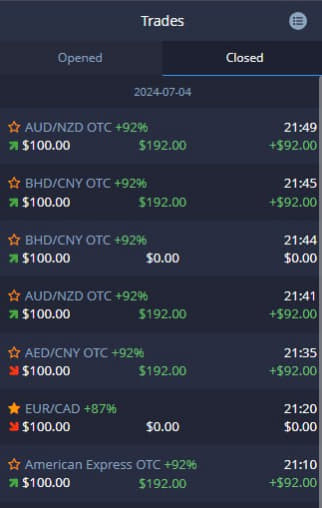Lista De Dorinte Fashionbeans 30 Ianuarie 2015
As part of our country specific Binary Options guides and articles below you are going to find a wealth of information that will be of interest to all US Binary Options traders or in fact anyone who is thinking of basing their up and coming trades on companies based in the US.
Is Pocket Option real or fake? Pocket Option has a mixed reputation. While it has a large user base and positive reviews from some traders, there have also been reports of withdrawal delays, account freezes, and issues with customer support. Some traders have also expressed concerns about the platform's legitimacy and potential scams.
How to turn $100 dollars into $1,000 in a month?
We will also be introducing you to some of the top rated US trader friendly Binary Options Brokers who will offer you a large and very diverse of trading opportunities and each Broker listed is licensed and regulated and offers either an online or an online and mobile trading platform to their clients.
Deposit: $10 Payout: 85%*
* Amount to be credited to account for a successful trade
Introduction Lista De Dorinte Fashionbeans 30 Ianuarie 2015

We want all of our US based Binary Options trading website visitors to be able to place their chosen trades seamlessly and effortlessly as we are sure you do too if you are one of those traders. As such we would like to present to you the following Brokers who are listed as our top rated Binary Options Brokers, each of which are fully licensed and regulated and each offer something unique to their customers.
Goptions – One thing that you may notice if you have experience of placing Binary Options trades at some online Brokers is that if you are based in the US you may have to make some compromises in regards to the amount of time you have to wait to get paid your withdrawals.
However, one Broker who has built us a solid reputation in regards to paying their winning traders in the very fastest possible time frames is Goptions. With that in mind please do checkout their website for you will find an overview of all of their payout time frames based on just which withdrawal options you have chosen to utilize.
CherryTrade – Please also take a look over our review of CherryTrade is you are a US based Binary Options trader, for they are another of our highly rated Brokers that can and always have been able to cater for traders based in any US State.
One thing that may impress you is the speed at which they are able to process all winning cash outs, they will never drag their feet when it comes to getting your withdrawals sent back to you in a very fast timeframe. Plus with plenty of different banking options readily available on their highly secure banking interface making a deposit or withdrawal is completely hassle free.
The range and diversity of their daily trading opportunities is impressive which is why lots of US based traders regularly place their trades at CherryTrade. Take a look over their website for details of their currently available sing up bonus offer which is quite large in size and offers tremendous value.
US Financial Standing
As one of the world’s major economies as a Binary Options trader or Forex trader you should try and amass as much information as you can on American is you are looking to place any type of Forex Trade or Binary Options based around the US Dollar or any country based in the US. With that in mind the following section will enlighten you of several different aspect of the economy of the US.
National Bank –The US Banking Regulator is the Board of Governors of the Federal Reserve System, if you required additional information on the Board of Governors of the Federal Reserve System its website is packed full of information in regards to policy and regulation of all US banks.
Currency – The currency of the US is the US Dollar, should you be looking o place Forex trades with that currency as one of the pairings then you will of course need to know its abbreviation which is USD.
Official Credit Rating – The US economy is currently classed as one of the stronger worldwide ones and this is reflected in its current credit rating which for reference has been classified by Standard & Poor’s as AA + and by Moody’s as Aaa and the US has been given a Moody’s outlook as being STA.
International Reserves – The US has huge amount of International Reserves as you might expected from a major worldwide economy and currently those international reserves are valued at some of US$ 141.679 billion.
GDP Growth – The figures relating to real GDP growth in the last five years n the US is impressive and as such those figures are, 2010 2.5%, 2011 1.6%, 2012 2.3%, 2013 2.2% and in 2014 2.2%.
Main Market Sectors – Knowing how much any countries GDP is based on the main market sectors will enable you to choose which Binary Options trades to place and in the US the Agriculture market sector makes up 1.1% of GDP and the Industry market sector makes up 19.5% and the Services market sector makes up 79.4% of GDP.
Inflation – The rate of inflation in the US does appear to be under control and as such let us now revealed to you the rate of inflation over the last few years. In 2011 it was 3.1%, in 2012 it was 2.1%, in 2013 it was 7.4% and in 2014 the rate of inflation was 6.3%.